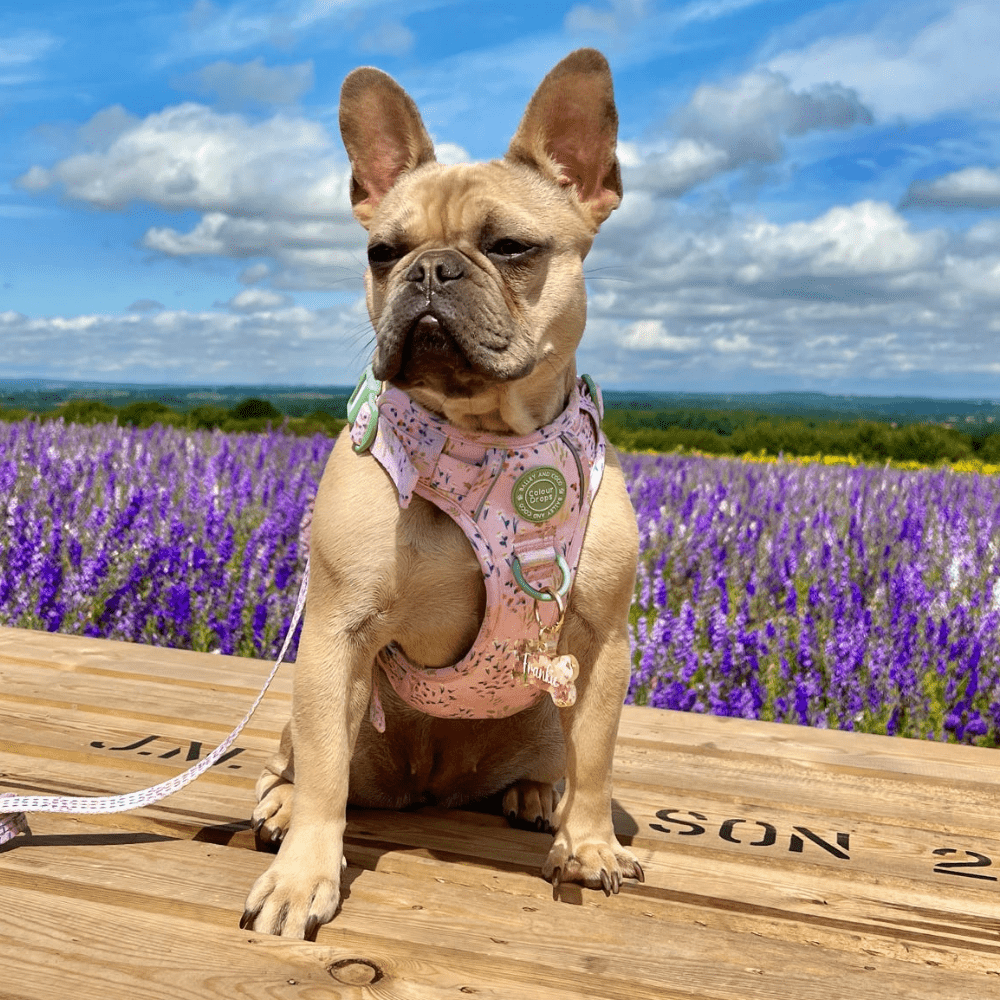Your Cart is Empty
French Bulldogs are lovable, determined, and… sometimes very strong pullers. The right no-pull harness can make walks calmer, safer, and more enjoyable—especially when paired with a simple, reward-based training plan. This guide explains why Frenchies pull, what to look for in a front-clip harness, how to fit it correctly, and the exact steps to teach loose-lead walking.

Already know you want the safest, training-friendly option? Explore our dedicated collection: French Bulldog Harnesses. Or compare styles and general fitting advice in the Complete French Bulldog Harness Guide.
Why Frenchies Pull (and Why a No-Pull Harness Helps)
French Bulldogs are compact and muscular with a low center of gravity. That, plus curiosity and excitement, often turns into steady tension on the lead. A front-clip no-pull harness helps by redirecting the pulling force toward you, making it easier to guide your dog back into position without pressure on the neck.
Front-Clip vs Back-Clip: Which Is Best for Training?
- Front-clip (no-pull): Lead attaches at the chest. When your Frenchie surges, the body gently pivots toward you—great for teaching loose-lead skills.
- Back-clip: Comfortable for calm walkers and casual use, but can give determined pullers extra leverage.
- Dual D-rings: The most versatile option—start with front-clip for training, switch to back-clip for relaxed strolls once skills improve.
What to Look For in a No-Pull Harness for French Bulldogs
- Front D-ring: Essential for no-pull guidance.
- Y-shape or ergonomic chest panel: Keeps shoulders free for natural movement.
- Four-point adjustability: A must for Frenchie proportions (stocky chest, shorter neck).
- Soft padding & breathable mesh: Reduces rubbing and heat build-up.
- Reflective trim: Visibility for dawn/dusk walks.
- Sturdy hardware: Secure buckles and reinforced stitching for daily use.
Our Training-Friendly Pick: Trail & Glow No-Pull Harness
Designed for comfort and control, the Trail & Glow Harness combines a front D-ring for training, a back D-ring for casual walks, breathable padding, and reflective details. See Frenchie-specific sizing and options here: French Bulldog Harnesses.

How to Fit a No-Pull Harness on a French Bulldog
- Measure first: Chest (widest point behind front legs) and neck base.
- Start loose: Place the harness so the chest panel sits flat; tighten gradually.
- Two-finger test: You should fit two fingers under all straps.
- Check freedom of movement: Shoulders and elbows must move freely without rubbing.
- Lead point: Attach to the front D-ring during training, then switch to back D-ring for maintenance walks.
Need full sizing help? See our walkthrough: Best Harness for French Bulldog UK Guide.
Step-by-Step: Loose-Lead Training for Pulling Frenchies
- Gear up: Fit your front-clip harness and use a standard 1.2–1.8 m lead.
- Reward position: Mark and treat when the lead slackens and your dog is by your side.
- Be a tree: If they pull, stop. Wait for slack. Mark, reward, then move forward.
- Change direction: Gently turn away when tension builds; reward as your Frenchie follows.
- Short sessions: 3–5 minutes at first; end on a win.
- Level up: Gradually add distractions and different routes.

Common Mistakes (and Quick Fixes)
- Too loose: A sloppy fit rubs and twists. Re-check the two-finger rule.
- Only back-clip: Persistent pullers need the front D-ring during training.
- Inconsistent rewards: Pay for position and slack—precision matters.
- Over-long sessions: Keep early practice short, positive, and frequent.

FAQs About No-Pull Harnesses for French Bulldogs
Are no-pull harnesses safe for French Bulldogs?
Yes. Unlike collars, they avoid neck pressure. With proper fit and training, they’re safe and comfortable.
Can I leave a no-pull harness on all day?
We recommend using it for walks and training only—remove at home for comfort and to prevent rubbing.
Which size should I pick?
Most adult Frenchies wear Small or Medium. Always measure chest and neck before ordering. See our guide for sizing charts.
Conclusion
A no-pull harness is a game-changer for strong-willed French Bulldogs. It ensures safety, reduces pulling, and sets the stage for calm, happy walks. Pair the right gear with reward-based training, and you’ll see progress faster than you think.
